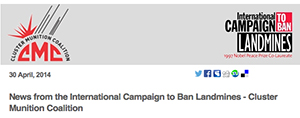02 July 2010
ICBL Statement on International Cooperation and Assistance - Clearance
Intersessional Standing Committee Meetings, 25 June 2010. The ICBL would like to thank Norway again for holding this special session. We hope sessions like this will breathe new life into the discussion on the cost-efficient, effective and results-driven implementation of the treaty in general. As usual, the ICBL would like to raise some comments that we hope will provoke responses and discussion - today and afterwards. These comments come from our mine action operators as well as our broader observations from a treaty implementation perspective.
In general, while ICBL has always called for the need for sustained and high levels of funding, we agree with Norway in that we should not just be talking about dollar figures, but also about what results we are seeing from these investments. Funding over the last 10 years has been substantial and constant. But we need to focus much more on making the most of such funds so that that the remaining requirements for mine action can best be met in a rapid, fair, and transparent manner.
We have spent a lot of time in recent years talking about increasing the efficiency of mine action through "land release", but we have not spent much time exploring mine action funding and management systems, where perhaps much larger time and financial efficiencies could be found. At the end of the day, there is only so much efficiency that can be squeezed out of mine survey and clearance while keeping them safe and effective. But there may still be much more room for finding savings of time and money at the systemic level - both national and international. Here are some of the areas where we think more reflection is needed to get better results on Article 5 within the means that already exist.
First of all, we find that national mine action plans need to be much more needs-based, with agreed criteria, objectives and results indicators for efficiency, effectiveness and impact. The plans should not only focus on clearance itself, but also on concrete needs in the area capacity building, coordination and other structures that are now almost always assumed to be needed in each and every situation. For example, states with small mine contamination should evaluate the best size and set up for a coordination body - does it need to be an independent entity, or would it make more sense to place it inside existing structures that would be also responsible to deal with the residual problem? On a broader level we can ask a related question: what is the right ratio between funds spent on clearance and funds spent on coordination? At the international level, our main point is that we would like to see the same degree of transparency and accountability requested of all the actors. While mine action operators for a long time have been subjected to, and willingly accepted, internationally recognized results-based planning and reporting, this has not been equally true for all other forms of support.
For example, while direct support from States Parties are automatically subjected to a results-framework, money going through other types of channels like trust funds seems to have fewer demands in terms of results reporting put on them. More assessment and evaluation could only be positive for learning what works and what does not.Heavy bureaucracies associated with some multilateral channels can mean long delays between when a donor makes a grant and when the people in the field receive the money they need to begin operations. Again I return to the example of Chad where $5 million took over 15 months to get from the donor, through the UN Voluntary Trust Fund and then from the UNDP to the operator. This is an extreme, but not an isolated example.
Such inefficiency is not only damaging to the state trying to meet its treaty obligations but also to the affected populations that are waiting to use the land. There is also an evidence bank from Gaza, Lebanon, Sudan and other places indicating that some technical, coordinating or advisory assistance is very expensive and often inefficient. The goal here is not to point fingers, but if we are looking to do more with a limited pot of money, these are also places where we should explore how to trim costs and improve productivity per dollar spent.
One suggestion would be to ask various funding mechanisms to provide more information - for example at standing committees - on how they allocate funds (through grants, tendering process), to whom (national NGOs, INGOs, commercial contractors, coordination bodies,etc.) and for what purposes (clearance, coordination, QA, VA), as well as how much time it takes from when funds are received into this mechanism until they are actually being used by the recipient of the funds.
On a final note, we would like to emphasize the cooperation element of Article 6. The ICBL has always emphasized that all States Parties are in a position to assist through financial, technical, or other forms of support. Again, if we start focusing more on concrete needs and results, we should be able to find much more opportunities for all states to contribute. But we might need to find better ways for states to exchange information on what they need or have to offer in terms of technical and other support.
Another form of cooperation we would like to encourage is the kind of strategic partnership like the one Norway has begun with Mozambique. When donor states do not just allocate funds, but also engage in regular discussions about progress and challenges, this should be an excellent way to foster commitment on behalf of both the donor and the affected state.We look forward to more discussion on these urgent topics in the coming months and years.
Thank you.


